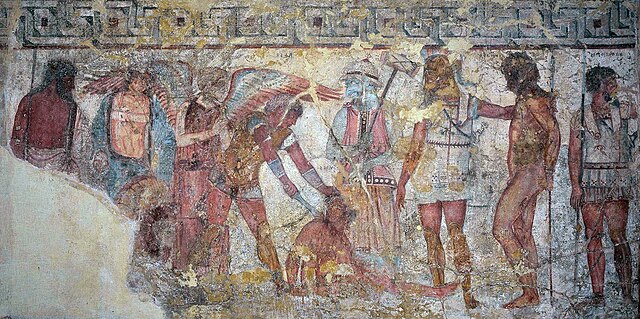A rhapsode or, in modern usage, rhapsodist, refers to a classical Greek professional performer of epic poetry in the fifth and fourth centuries BC. Rhapsodes notably performed the epics of Homer but also the wisdom and catalogue poetry of Hesiod and the satires of Archilochus and others. Plato's dialogue Ion, in which Socrates confronts a star player rhapsode, remains the most coherent source of information on these artists. Often, rhapsodes are depicted in Greek art, wearing their signature cloak and carrying a staff. This equipment is also characteristic of travellers in general, implying that rhapsodes were itinerant performers, moving from town to town. Rhapsodes originated in Ionia, which has been sometimes regarded as Homer's birthplace, and were also known as Homeridai, disciples of Homer, or "singers of stitched lays."
Image: Rhapsode Cazes
The Iliad is one of two major ancient Greek epic poems attributed to Homer. It is one of the oldest extant works of literature still widely read by modern audiences. As with the Odyssey, the poem is divided into 24 books and was written in dactylic hexameter. It contains 15,693 lines in its most widely accepted version. Set towards the end of the Trojan War, a ten-year siege of the city of Troy by a coalition of Mycenaean Greek states, the poem depicts significant events in the siege's final weeks. In particular, it depicts a fierce quarrel between King Agamemnon and a celebrated warrior, Achilles. It is a central part of the Epic Cycle. The Iliad is often regarded as the first substantial piece of European literature.
Inscription of lines 468–473, Book I. 400–500 AD, from Egypt. On display at the British Museum
Iliad, Book VIII, lines 245–253, Greek manuscript, late 5th, early 6th centuries AD
Thetis at Hephaestus' forge waiting to receive Achilles' new weapons. Fresco from Pompeii, 1st century
A detail of fresco from the François Tomb at Vulci, showing the sacrifice of Trojan slaves. From left to right: Agamemnon, ghost of Patroclus, Vanth, Achilles beheading a slave, Charun, Ajax the Great, a slave, Ajax the Lesser. 350-330 BC





